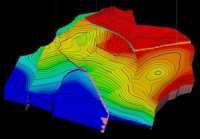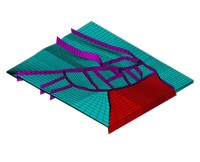


 |
 |
 |
In order to assess the practical potential of
geomechanical reservoir models the workflow was applied to a data set from a
reservoir in the Eastern Sirte basin of Libya. The reservoir geometry (faults
and lithological boundaries) as interpreted from 3D seismic was transferred to
a corresponding finite element model for geomechanical analysis. Model
predictions are compared to well data actually observed, i.e. stress
orientations (borehole breakouts) and fractures interpreted from image logs.
The case study shows that the present-day stress orientations including the
local perturbations near faults can be predicted with considerable accuracy
even if the reservoir and fault geometries are primarily derived from seismic
data, i.e. if well data for calibration is sparse. Fracture prediction is less
robust as it has to build on several poorly constrained input parameters like
magnitude and orientation of paleo-stresses, paleo-pore pressures and past rock
mechanical properties. Consequently, sufficient wells with fracture data are
required to calibrate the geomechanical model and provide a reliable basis for
fracture prognoses in the inter-well space.
The project was supported by
Wintershall Holding AG and the National Oil Corporation (NOC) of Libya. |
 |
| Publications and Presentations |
 |
HENK, A. & FRISCHBUTTER, A.(2010): Predicting stress
and fracture orientations with geomechanical reservoir models - lessons learned
from a case study. - AAPG 2010 Annual Convention & Exhibition, New Orleans,
USA, 14. April, 2010 (Best-of-EAGE talk).
HENK, A., FRISCHBUTTER, A. &
TAWENGI, K.S. (2010): Geomechanical reservoir models - a case study from the
Sirte Basin / Libya. - OIL GAS European Magazine, 1/2010: 18-22. |
 |
| Contact for more information |
|



